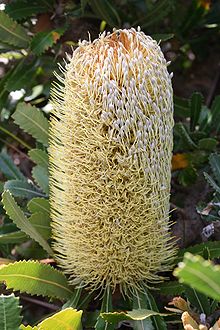
Banksia subg. Banksia is a valid botanic name for a subgenus of Banksia. As an autonym, it necessarily contains the type species of Banksia, B. serrata. Within this constraint, however, there have been various circumscriptions.

Banksia sceptrum, commonly known as the sceptre banksia, is a plant that grows in Western Australia near the central west coast from Geraldton north through Kalbarri to Hamelin Pool. It extends inland almost to Mullewa. First collected and grown by early settler James Drummond in Western Australia, it was described by Swiss botanist Carl Meissner in 1855.
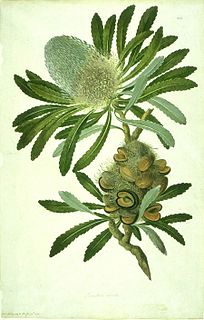
As with other flowering plants, the taxonomy of Banksia has traditionally been based on anatomical and morphological properties of the Banksia flower, fruiting structure and seed, along with secondary characteristics such as leaf structure and growth habit. Increasingly, molecular evidence from DNA is providing important new insights into relationships within the genus and between this and other genera in the Proteaceae.

Banksia lindleyana, commonly known as the porcupine banksia, is a species of woody shrub in the genus Banksia of the family Proteaceae. It generally grows as a small shrub to 1 m (3 ft) high with long narrow serrated leaves, and bright yellow oval or round inflorescences. Flowering occurs in late summer, after which time the flower spikes age and turn to brown and then grey, and develop up to 70 follicles. It occurs in the vicinity of Kalbarri, Western Australia. Found on sandy soils, the plant serves as a pollinator for a variety of bird and animal species.

Banksia praemorsa, commonly known as the cut-leaf banksia, is a species of shrub or tree in the plant genus Banksia. It occurs in a few isolated populations on the south coast of Western Australia between Albany and Cape Riche.
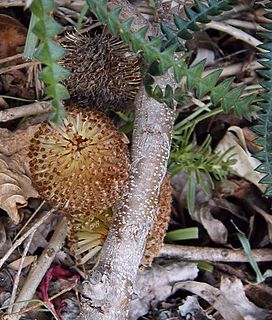
Banksia ser. Dryandroideae is a taxonomic series in the plant genus Banksia. First published by Carl Meissner in 1856, the name has had two circumscriptions. As presently circumscribed it is monotypic, containing only B. dryandroides.

Banksia ser. Abietinae is a valid botanic name for a series of Banksia. First published by Carl Meissner in 1856, the name has had three circumscriptions.
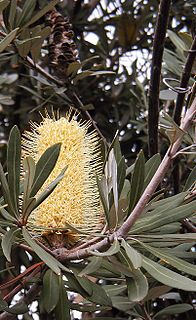
Banksia ser. Salicinae is a valid botanic name for a series of Banksia. First published by Carl Meissner in 1856, the name has had three circumscriptions.
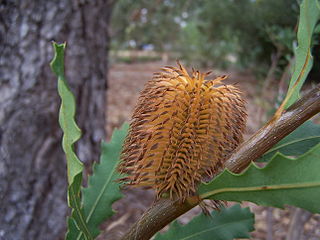
Banksia ser. Quercinae is a valid botanic name for a series of Banksia. First published by Carl Meissner in 1856, the name has had three circumscriptions.

Banksia ser. Cyrtostylis is a taxonomic series within the plant genus Banksia. First published at sectional rank by George Bentham in 1870, it was demoted to a series by Alex George in 1981. The name has had three circumscriptions.

Banksia ser. Crocinae is a taxonomic series in the genus Banksia. The series was first published by Alex George in 1981, but discarded by Kevin Thiele and Pauline Ladiges in 1996, and finally reinstated by George in 1999. Recent cladistic analyses suggest that it is monophyletic or nearly so.

George Bentham's taxonomic arrangement of Banksia was published in 1870, in Volume 5 of Bentham's Flora Australiensis. A substantial improvement on the previous arrangement, it would stand for over a century. It was eventually replaced by Alex George's 1981 arrangement, published in his classic monograph The genus Banksia L.f. (Proteaceae).
Kevin Thiele and Pauline Ladiges taxonomic arrangement of Banksia, published in 1996, was a novel taxonomic arrangement that was intended to align the taxonomy of Banksia more closely with the phylogeny that they had inferred from their cladistic analysis of the genus. It replaced Alex George's 1981 arrangement, but most aspects were not accepted by George, and it was soon replaced by a 1999 revision of George's arrangement. However some herbaria have continued to follow Thiele and Ladiges on some points.

Alex George's taxonomic arrangement of Banksia was the first modern-day arrangement for that genus. First published in 1981 in the classic monograph The genus Banksia L.f. (Proteaceae), it superseded the arrangement of George Bentham, which had stood for over a hundred years. It was overturned in 1996 by Kevin Thiele and Pauline Ladiges, but restored by George in 1999. A recent publication by Austin Mast and Kevin Thiele suggests that it will soon be overturned again.

Banksia subser. Longistyles is a valid botanic name for a subseries of Banksia. It was published by Kevin Thiele in 1996, but discarded by Alex George in 1999.

Banksia subser. Leptophyllae is a valid botanic name for a subseries of Banksia. It was published by Kevin Thiele in 1996, but discarded by Alex George in 1999.

Banksia subser. Sphaerocarpae is a valid botanic name for a subseries of Banksia. It was published by Kevin Thiele in 1996, but discarded by Alex George in 1999.

Banksia ser. Ochraceae is a valid botanic name for a taxonomic series within the plant genus Banksia. It was published by Kevin Thiele in 1996, but discarded by Alex George in 1999.

Banksia subser. Banksia is a valid botanic name for a subseries of Banksia. It was first used by Kevin Thiele in 1996, although as an autonym it is not considered to have been published per se. It was discarded by Alex George in 1999.

Banksia subser. Cratistylis is a valid botanic name for a subseries of Banksia. It was first published by Kevin Thiele in 1996 but discarded by Alex George in 1999.
